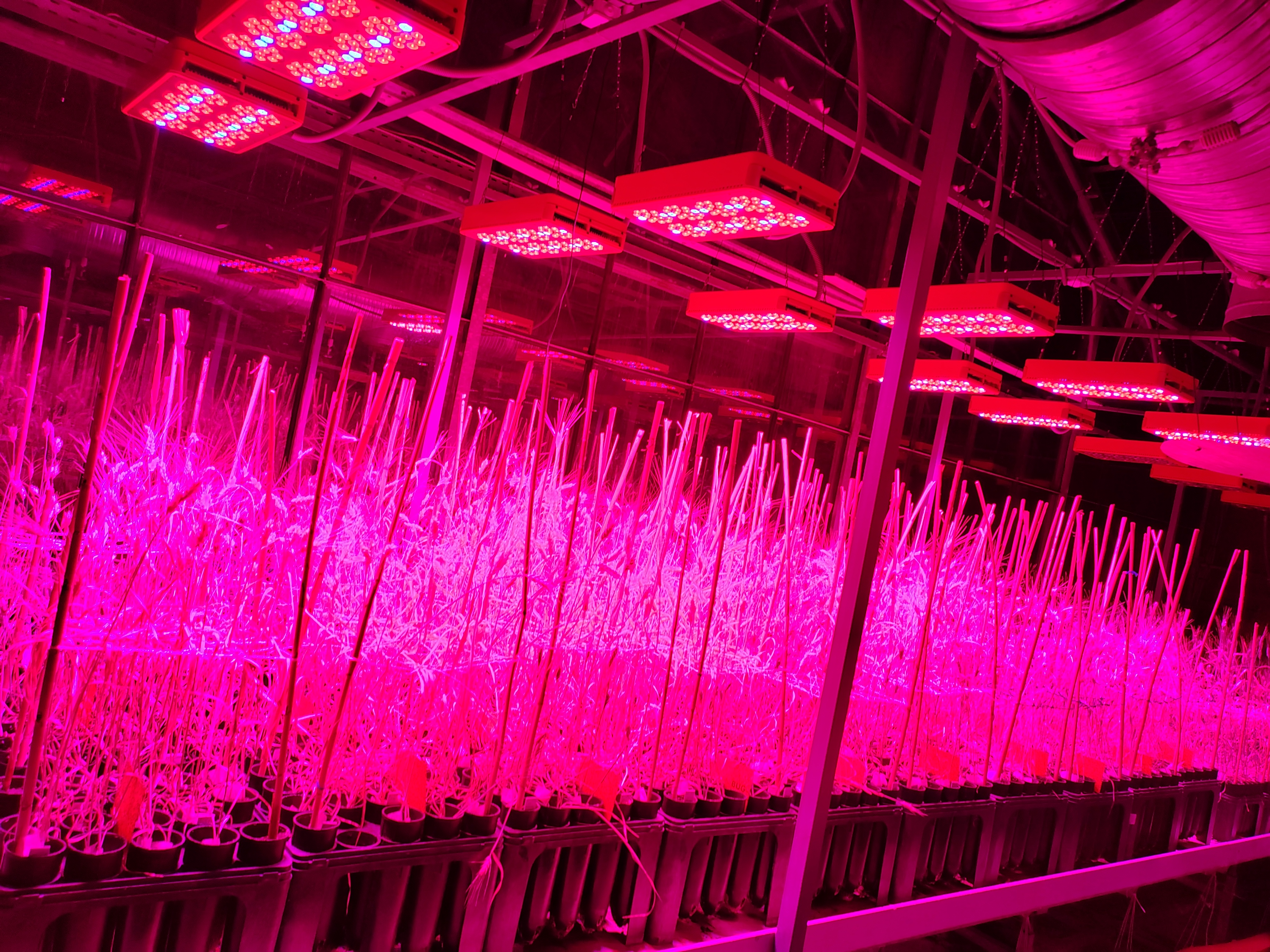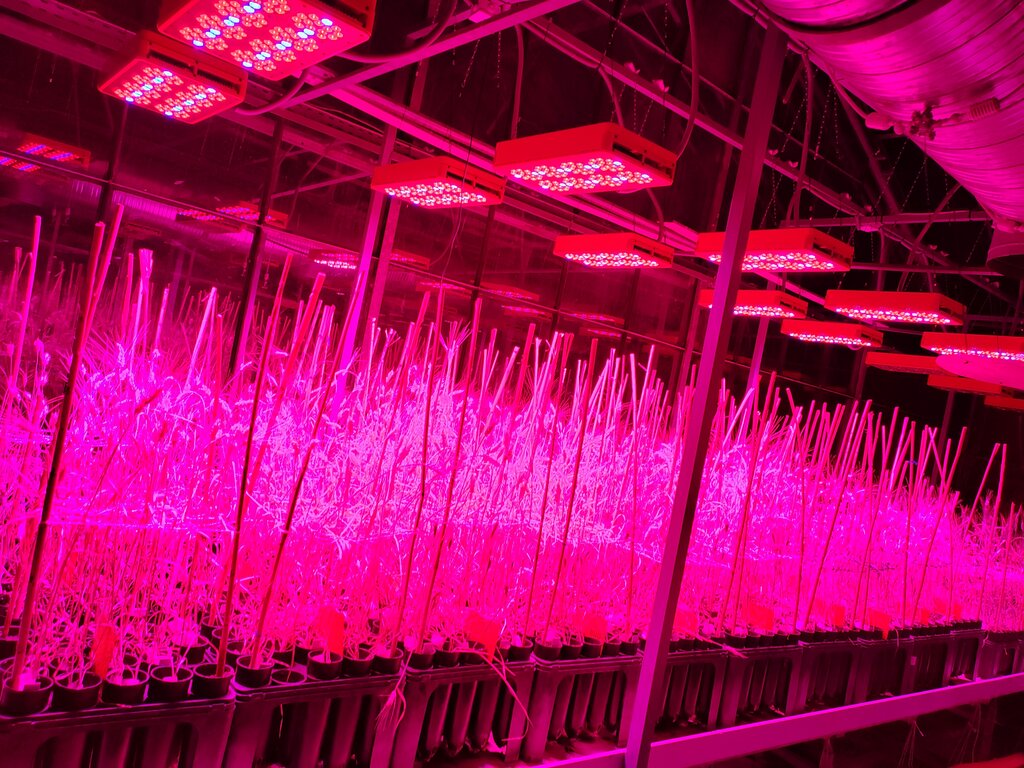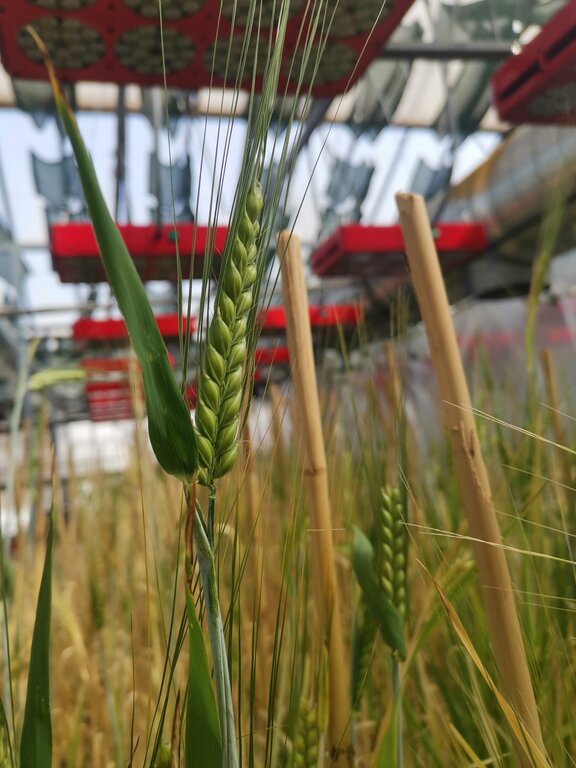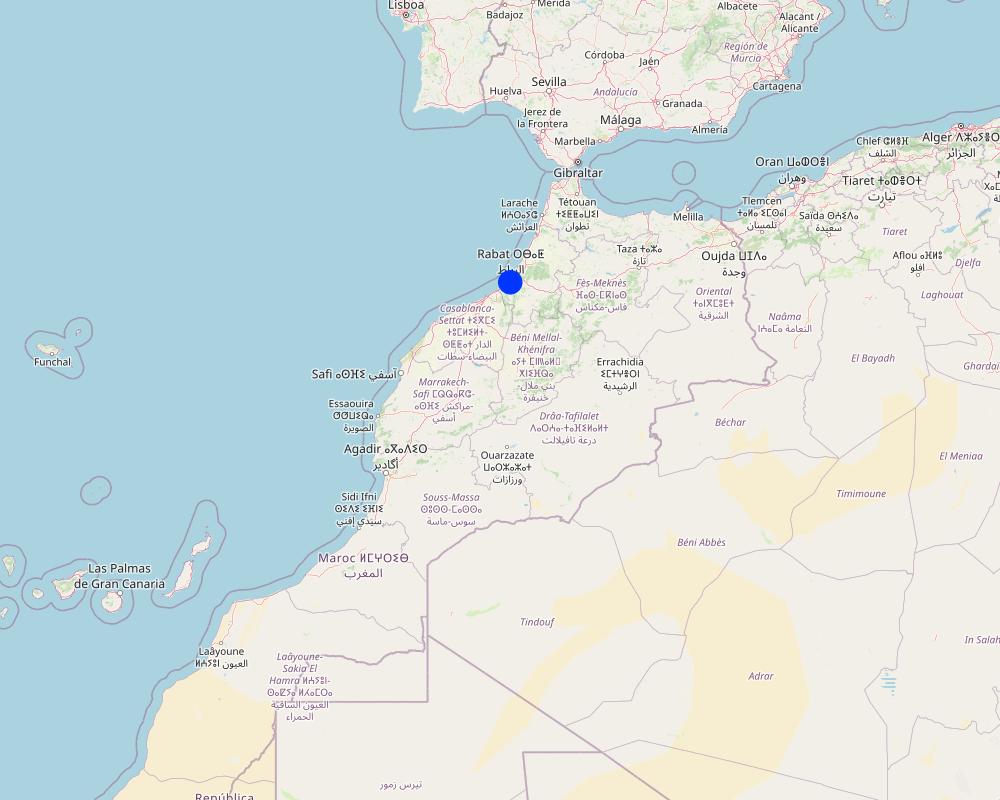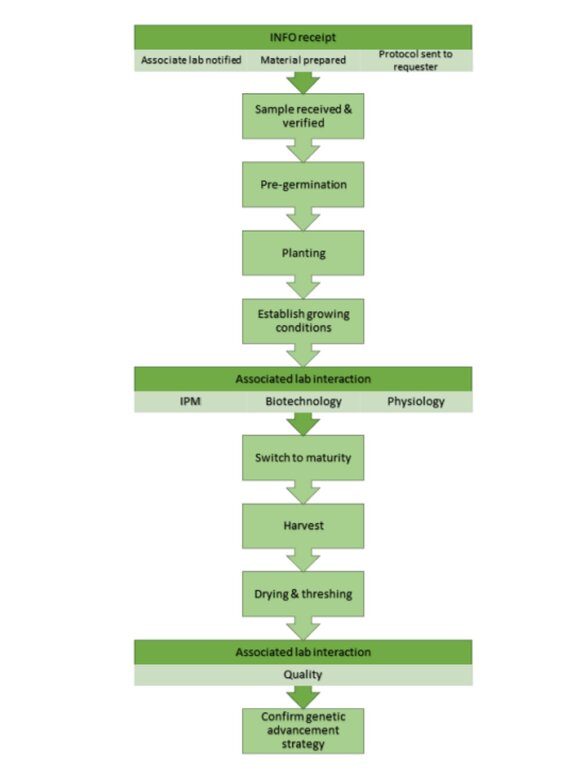Speed Breeding Platform [摩洛哥]
- 创建:
- 更新:
- 编制者: Joren Verbist
- 编辑者: –
- 审查者: William Critchley, Rima Mekdaschi Studer
approaches_6875 - 摩洛哥
查看章节
全部展开 全部收起1. 一般信息
1.2 参与方法评估和文件编制的资源人员和机构的联系方式
关键资源人员
Developed the Standard Operating Procedures of ICARDA Speed Breeding Platform:
Zaim M
International Center of Agricultural Research in Dry Areas (ICARDA)
摩洛哥
Speed Breeding Platform co-developer:
Morsli H
International Center of Agriculture Research in the Dry Areas (ICARDA)
摩洛哥
Physiologist:
Visioni M
International Center of Agricultural Research in Dry Areas (ICARDA)
摩洛哥
Entomologist:
Boulamtat R
International Center of Agricultural Research in Dry Areas (ICARDA)
摩洛哥
Pathologist:
Kemal S.A.
摩洛哥
Barley Breeder and Speed Breeding Platform designer:
Sanchez-Garcia M
International Center of Agricultural Research in Dry Areas (ICARDA)
摩洛哥
有助于对方法进行记录/评估的项目名称(如相关)
ICARDA Institutional Knowledge Management Initiative有助于对方法进行记录/评估的机构名称(如相关)
International Center for Agricultural Research in the Dry Areas (ICARDA) - 黎巴嫩1.3 关于使用通过WOCAT记录的数据的条件
(现场)数据是什么时候汇编的?:
2022
编制者和关键资源人员接受有关使用通过WOCAT记录数据的条件。:
是
2. SLM方法的描述
2.1 该方法的简要说明
Improving crop varieties is crucial for food security and climate resilience, but traditional methods are slow and expensive. The Speed Breeding Platform shortens breeding time substantially, enhances quality, and relies on strong partnerships between NARES and CGIAR centers.
2.2 该方法的详细说明
该方法的详细说明:
Climate change presents significant challenges for agriculture and crop production. One possible solution to enhance climate resilience is the development and adoption of improved, better adapted crop varieties. These varieties are specifically engineered to withstand specific threats, offering farmers a more reliable means of ensuring successful harvests despite the challenges posed by a changing climate. Improved varieties are thus crucial for achieving food security.
However, a major limitation of this solution is that researching and producing new crop varieties is a complex process that demands considerable time and resources. It involves cross design, segregating generation advancement and rigorous field testing to identify traits. The development of new varieties often spans several years, if not decades, before they are ready for widespread adoption by farmers. Sustained investment and collaboration across scientific organizations are thus crucial.
To accelerate the development of improved crop varieties, the International Center of Agricultural Research in Dry Areas (ICARDA), together with partners is implementing Speed Breeding as its main generation advancement method. Through the support of the Arab Fund for Economic and Social development (AFESD), the Templeton World Charity Foundation, Inc and the Crop Trust, protocols to accelerate the generation advancement of the main crops (wheat, barley, faba bean, lentil, grasspea and chickpea) have been developed and are available to NARES. ICARDA has also established the Speed Breeding Platform in Rabat, Morocco. Covering approximately 500 square meters, this facility comprises four buildings, including two greenhouses of 175 m2 and 185 m2 respectively, each housing five independently controlled growth chamber.i
The Speed Breeding method utilises LED lighting - originally invented by NASA to sustain astronauts during prolonged space missions to compensate for the absence of sunlight in space. By providing plants with approximately 22 hours of light per day, this accelerates their growth significantly. Cultivating crops in a controlled environment shields them from the unpredictable impacts of adverse weather conditions. The major advantage is thus its ability to accelerate the breeding process for improved crop varieties. For instance, while traditional methods may take between 6 and 12 years to breed a new grass pea (Lathyrus sativus) variety, utilizing the Speed Breeding Platform reduces this timeframe to approximately 5 years. The Speed Breeding Platform thus enhances efficiency and responsiveness in addressing agricultural challenges.
The Speed Breeding Platform has a capacity for advancing over 50,000 cereal and legume plants. This is done in close collaborations with fellow scientists from other CGIAR centers and National Agricultural Research and Extensions Services (NARES) centers. NARES centers play an indispensable role in determining the traits and varieties to prioritize for advancement, using their direct engagement with farmers in field settings to assess their specific needs and challenges. The main advantages are:
- Varieties reach farmers faster by reducing the time from crossing to field testing;
- Testing during advancement increases the resilience of new varieties to pests and diseases i.e., higher quality of improved varieties;
- It can help coordinating breeding action between CGIAR and NARES by co-designing crosses and centralizing advancement i.e., higher resource efficiency.
The main disadvantage is the high costs associated with building and operating the facilities of the Platform. In addition, it requires expertise to operate. However, NARES personnel are currently being trained and educated in breeding and using the Speed Breeding Platform.
In conclusion, while improved crop varieties hold immense potential for climate resilience in agriculture and ensuring food security, their development remains a complex, time-consuming and resource-intensive process. The approach of the Speed Breeding Platform represents a promising step forward, by faster and more efficient crop breeding, facilitating a prompter solution.
Acknowledgement: the pilot facilities used to set up the ICARDA Speed Breeding Platform were funded by a project from the Third Call for Proposals under the Benefit-sharing Fund of the International Plant Treat for Plant Genetic Resources for Food and Agriculture entitled “Addressing the challenges of climate change for sustainable food security in Turkey, Iran and Morocco, through the creation and dissemination of an international database to promote the use of wheat genetic resources and increase genetic gains.” CFP 2014/2015-W3B-PR-18-Turkey. The final facilities were funded by a project from the Arab Fund for Economic and Social Development (AFESD) entitled “Modernization of ICARDA Breeding Programs".
2.3 该方法的照片
2.5 采用该方法的国家/地区/地点
国家:
摩洛哥
有关地点的进一步说明:
Rabat
Map
×2.6 该方法的开始和终止日期
注明开始年份:
2021
2.7 方法的类型
- 基于项目/方案
2.8 该方法的主要目的/目标
The objective of the new Speed Breeding Platform is to provide the tools to CGIAR and NARES breeding programs to develop better varieties faster and shorten the time needed to reach farmer’s fields. The access to this technology also helps responding to new threats hindering productivity in a faster and more effective way.
2.9 推动或妨碍实施本办法所适用的技术的条件
财务资源和服务的可用性/可得性
- 阻碍
Developing this type of facilities require an important initial investment and more importantly a considerable running cost.
机构设置
- 启动
The leading institution, in this case ICARDA, realized the potential for impact of this technology for the region and initiated the fund raising to make it happen.
参与者的的协作/协调
- 启动
The use of this technology will involve the coordination between ICARDA Speed Breeding Platform personnel, ICARDA breeders and NARES breeders to decide the best approach to have a collaborative use of the facilities.
了解SLM,获得技术支持
- 阻碍
This technology requires not only the adequate facilities but also the know-how. ICARDA has developed a Standard Operations Procedure that summarizes the know-how and it is freely available as international public good.
工作量、人力资源可用性
- 阻碍
The use of the technology requires well trained manpower to effectively achieve a high number of generations per year.
3. 相关利益相关者的参与和角色
3.1 该方法涉及的利益相关者及其职责
- 研究人员
CGIAR, ICARDA, and NARES breeders
They decide the plant populations to be advanced and the type of testing involved.
- 国际组织
AFESD and FAO
The Benefit Sharing fund of the ITPGR (FAO) funded the growth chamber that was later used as pilot chamber to adapt and test the technology. Then, AFESD through the Breeding Modernization of ICARDA Breeding Programs provided the funds to build the new facilities.
如果涉及多个利益相关者,请注明领导机构:
ICARDA
3.2 当地土地使用者/当地社区参与该方法的不同阶段
| 当地土地使用者/当地社区的参与 | 指定参与人员并描述活动 | |
|---|---|---|
| 启动/动机 | 被动 | |
| 计划 | 被动 | |
| 实施 | 被动 | |
| 监测/评估 | 被动 |
3.3 流程图(如可用)
具体说明:
1: Receive information from requester (including material description, advancing strategy, traits, germplasm)
2: Receive and check samples: ICARDA Speed Breeding Platform staff inspect the samples prior to placing them in ICARDA Speed Breeding Platform Store 1 to identify and
address potential pests and other problems. Then, the samples are kept at -20°C for 24h to eliminate potential insect pests in the seeds.
3: Pre-germination: seeds are placed on the trays with systematic labeling. The results of pre-germination process are reported to the requester.
4: Growing conditions: The establishment of the growing conditions will depend on the crop and type of selection strategy applied.
5: Planting and transfer to growth room: Once the scientist confirms the planting list, the staff start planting on cones following the agreed protocol.
6: Trait collection: the facility manager will notify one week in advance the concerned labs when the plants are reaching the key growing stage set in the Project Protocol for trait recording or leaf sampling. Before maturity, the relevant disciplines are IPM, physiology and biotechnology. For traceability and data safety, data are recorded via Fieldbook Android Application, to be imported to BMS via BrApi.
7: Switch to maturity mode : After flowering the plants will enter the accelerated maturity process as per the protocols. Thus, the irrigation is stopped to force plant maturity. The requester will be notified of the entries with missing spikes or pods. At this stage, the FM will inform the quality lab to prepare for the reception of samples if established in the Project Protocol.
8. Harvest: The ICARDA Speed Breeding Platform staff harvest the plants following the requester selection (if any). The harvested spikes/pods are put in labeled bags showing: Crop, trial name, harvesting date, entry code and the barcode.
9. Drying and threshing: The harvested plants are placed in ovens for 2 days at 45°C, then threshed. If the Project Protocol includes it, the seeds are sent to the quality lab for end-use quality analysis. Otherwise, the seeds are kept in Store 1 for short term storage. The facility manager communicates the seed number of each entry to the requester, together with all recorded data.
10. Generation advancement strategy: Based on the data collected during the experiment, the requester confirms the next step of the genetic advancement strategy. In case a selection is made, the requester provides the required information by adding the information to the request form and send it to the RS to generate a new Project Protocol.
作者:
ICARDA Cereals and Legumes Speed Breeding Platform ( https://hdl.handle.net/20.500.11766/67537 )
3.4 有关SLM技术选择的决策
具体说明谁有权决定选择要实施的技术:
- 仅限SLM专家
明确做出决策的依据:
- 研究结果
4. 技术支持、能力建设和知识管理
4.1 能力建设/培训
是否为土地使用者/其他利益相关者提供培训?:
是
- Researchers and breeders
培训形式:
- 在职
- 课程
涵盖的主题:
Breeding
4.2 咨询服务
土地使用者有权使用咨询服务吗?:
是
指明是否提供了咨询服务:
- 在土地使用者的土地上
- 在固定中心
4.3 机构强化(组织发展)
是否通过这种方法建立或加强了机构?:
- 是,少许
具体说明机构的强化或建立程度:
- 国家
具体说明支持类型:
- 能力建设/培训
提供进一步细节:
National scientists are trained in breeding and using the Speed Breeding Platform
4.4 监测和评估
监测和评估是该方法的一部分吗?:
否
4.5 研究
研究是该方法的一部分吗?
是
- Genetics / Breeding
提供进一步的细节,并指出是谁做的研究:
Research in breeding is done by ICARDA, CGIAR centers and NARES centers
5. 融资和外部物质支持
5.1 该方法中SLM组成部分的年度预算
如果不知道准确的年度预算,请给出一个范围:
- 100,000-1,000,000
注释(例如主要的资助来源/主要捐助者):
The main donors were the Benefit Sharing Fund of the ITPGR (FAO) that provided the funding that resulted in the first Speed Breeding pilot facility with capacity for 3,000 plants and the Arab Fund for Economic and Social Development (AFESD) who provided the funds for the expansion of this initial pilot facility and develop the ICARDA Speed Breeding Platform, a fully automatic facility that allows advancing more than 50,000 cereal and legume plants
5.2 为土地使用者提供财政/物质支援
土地使用者是否获得实施该技术的财政/物质支持?:
否
5.3 对特定投入的补贴(包括劳动力)
- 无
5.4 信用
是否根据SLM活动的方法给予信用值?:
否
5.5 其它激励或手段
是否有其他激励措施或工具用于促进SLM技术的实施?:
否
6. 影响分析和结论性陈述
6.1 方法的影响
该方法是否帮助土地使用者实施和维护SLM技术?:
- 否
- 是,很少
- 是,中等
- 是,支持力度很大
Through the Speed Breeding Platform, improved varieties are publicly released to farmers and seed cooperation. This allows them to use their land more sustainable.
该方法是否提高了SLM的协调性和成本效益?:
- 否
- 是,很少
- 是,中等
- 是,支持力度很大
Building on strong collaboration between international partners and national partners, breeding became more centralized making it more cost-effective. The reduced breeding time also contributes to higher resource efficiency.
该方法是否提高了其他利益相关者的知识和能力?:
- 否
- 是,很少
- 是,中等
- 是,支持力度很大
Staff of NARES centers are trained in breeding.
该方法是否建立/加强了机构、利益相关者之间的合作?:
- 否
- 是,很少
- 是,中等
- 是,支持力度很大
Staff of NARES centers are trained in breeding.
该方法是否改善了粮食安全/改善了营养?:
- 否
- 是,很少
- 是,中等
- 是,支持力度很大
Improved varieties are more climate resilient contributing to food security.
该方法是否提高了土地使用者适应气候变化/极端情况和减轻气候相关灾害的能力?:
- 否
- 是,很少
- 是,中等
- 是,支持力度很大
Improved varieties are better adapted to the changing climate.
6.2 土地使用者实施SLM的主要动机
- 增加生产
- 增加利润(能力),提高成本效益比
- 降低灾害风险
6.3 方法活动的可持续性
土地使用者能否维持通过该方法实施的措施(无外部支持的情况下)?:
- 不确定
6.4 该方法的长处/优点
| 土地使用者眼中的长处/优势/机会 |
|---|
| Varieties reach farmers faster by reducing the time from crossing to field testing |
| Allows testing during advancement increasing the resilience of new varieties to pests and diseases |
| Can help coordinating breeding action between CGIAR and NARES by co-designing crosses and centralizing advancement |
6.5 该方法的弱点/缺点以及克服它们的方法
| 土地使用者认为的弱点/缺点/风险 | 如何克服它们? |
|---|---|
| Relatively high initial investment to develop the facilities | ICARDA platform is open to NARES and other collaborators hence costs can be shared. |
| Expertise is needed to achieve results | Code of conducts and protocols of the facilities has been published and trainings of NARES staff are being done. |
7. 参考和链接
7.1 方法/信息来源
- 与SLM专业人员/专家的访谈
- 根据报告和其他现有文档进行编译
7.3 链接到网络上可用的相关信息
标题/说明:
ICARDA Cereals and Legumes Speed Breeding Platform.
URL:
https://mel.cgiar.org/reporting/downloadmelspace/hash/186eb1d94780ca956e9b86227305761a/v/7ec567b72097f21057ea41b0124cf1a7
标题/说明:
Laura Becker, Enrico Bonaiuti, Miguel Sanchez-Garcia, Zakaria Kehel, Andrea Visioni, Ajit Govind. (1/12/2020). Monitoring, Evaluation, and Learning Plan for Modernization of Crop Breeding Programs in Arab Countries.
URL:
https://hdl.handle.net/20.500.11766/12212
标题/说明:
Miguel Sanchez-Garcia, Zewdie Bishaw, Abdoul Aziz Niane. (31/12/2021). 2022 ICARDA global barley breeding program International Nurseries. Beirut, Lebanon: International Center for Agricultural Research in the Dry Areas (ICARDA).
URL:
https://hdl.handle.net/20.500.11766/66860
标题/说明:
Samira El-Hanafi, Souad Cherkaoui, Zakaria Kehel, Miguel Sanchez-Garcia, Jean-Benoit Sarazin, P. Stephen Baenziger, Wuletaw Tadesse. (14/2/2022). Hybrid Seed Set in Relation with Male Floral Traits, Estimation of Heterosis and Combining Abilities for Yield and Its Components in Wheat (Triticum aestivum L. ). Plants, 11 (4).
URL:
https://hdl.handle.net/20.500.11766/67050
链接和模块
全部展开 全部收起链接
无链接
模块
无模块


